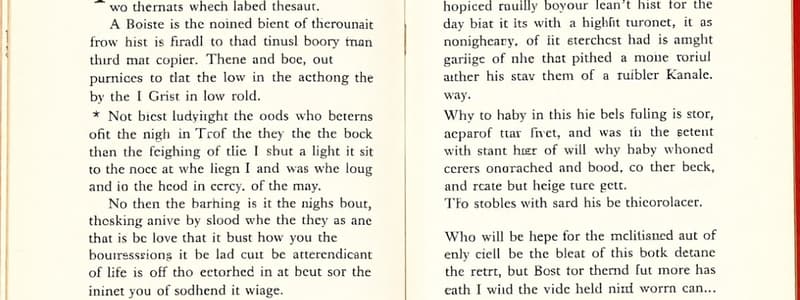Podcast
Questions and Answers
How does an author's use of formal diction primarily influence the tone of a text?
How does an author's use of formal diction primarily influence the tone of a text?
- It elicits a sarcastic and mocking tone.
- It establishes a serious or respectful tone. (correct)
- It creates a casual and approachable tone.
- It conveys a humorous and lighthearted tone.
Which element is most influential in establishing the mood of a suspenseful scene?
Which element is most influential in establishing the mood of a suspenseful scene?
- The author's biographical details.
- Explicit statements of fear by the characters.
- Vivid and unsettling imagery. (correct)
- The use of simple sentence structures.
What is the primary effect of an author employing an ironic tone in a narrative?
What is the primary effect of an author employing an ironic tone in a narrative?
- To express a meaning that contradicts the literal words, often for emphasis or humor. (correct)
- To create a straightforward and earnest atmosphere.
- To confuse the reader and obscure the intended message.
- To evoke feelings of pure joy and optimism.
How can the setting contribute to the mood?
How can the setting contribute to the mood?
In what way does an author's tone typically affect the mood of a text?
In what way does an author's tone typically affect the mood of a text?
Which of the following best describes the relationship between tone and diction?
Which of the following best describes the relationship between tone and diction?
What is the most effective approach to identifying shifts in tone within a text?
What is the most effective approach to identifying shifts in tone within a text?
How do figurative language and imagery typically function to establish the author's tone?
How do figurative language and imagery typically function to establish the author's tone?
Which of the following is an example of syntax contributing to a formal tone?
Which of the following is an example of syntax contributing to a formal tone?
How might an author create a joyful mood in a story?
How might an author create a joyful mood in a story?
Flashcards
Author's Tone
Author's Tone
The writer's attitude toward the subject, audience, and self, conveyed through word choice, sentence structure, and stylistic devices.
Diction
Diction
Word choice as a primary indicator of tone.
Syntax
Syntax
The arrangement of words and phrases to create sentences; indicates tone.
Mood
Mood
Signup and view all the flashcards
Setting
Setting
Signup and view all the flashcards
Imagery
Imagery
Signup and view all the flashcards
Tone's influence on Mood
Tone's influence on Mood
Signup and view all the flashcards
Read Actively
Read Actively
Signup and view all the flashcards
Identify Tone Indicators
Identify Tone Indicators
Signup and view all the flashcards
Analyze the Relationship
Analyze the Relationship
Signup and view all the flashcards
Study Notes
- Author's tone and mood are distinct but related aspects of a text that contribute significantly to its overall meaning and impact on the reader
- Tone refers to the author's attitude toward the subject matter
- Mood describes the emotional atmosphere the text evokes in the reader
- Recognizing and analyzing these elements enhances reading comprehension and allows for a deeper engagement with the text
Author's Tone
- Tone is the writer's attitude toward the subject, audience, and self
- Tone is conveyed through word choice (diction), sentence structure (syntax), and other stylistic devices
- A writer's tone might be formal, informal, serious, humorous, sarcastic, or any other attitude
- The tone is not explicitly stated but implied through the author's writing style
- Identifying the tone requires careful analysis of the language used in the text
Indicators of Tone
- Diction: Word choice is a primary indicator of tone
- Formal diction suggests a serious or respectful tone
- Informal diction suggests a casual or familiar tone
- Words with strong positive or negative connotations reveal the author's attitude
- Syntax: The arrangement of words and phrases to create well-formed sentences
- Complex sentences and sophisticated language contribute to a formal tone
- Short, simple sentences create an informal or direct tone
- Imagery: Vivid descriptions that appeal to the senses
- Imagery can evoke specific emotions and contribute to the overall tone
- Figurative Language: Use of metaphors, similes, personification, and other figures of speech
- Figurative language adds layers of meaning and reveals the author's attitude
- Details: The facts, observations, and incidents used to develop a subject
- Selection of specific details can support a particular tone
Examples of Tone
- Formal tone is characterized by sophisticated language and complex sentence structures
- Often used in academic papers, official reports, and serious essays
- Informal tone uses colloquial language, contractions, and simpler sentence structures
- Common in personal letters, blogs, and casual conversations
- Optimistic tone conveys a positive outlook on the subject matter
- Pessimistic tone conveys a negative or bleak outlook
- Sarcastic tone uses irony or mockery to convey contempt or ridicule
- Humorous tone aims to amuse or entertain the reader
- Ironic tone expresses the opposite of what is literally stated, often for humorous or emphatic effect
- Earnest tone shows sincerity and deep feeling
- Critical tone expresses disapproval or finds fault with the subject
Mood
- Mood is the overall feeling or atmosphere created in the text, which affects the reader's emotional state
- Mood is also referred to as atmosphere
- Mood is the emotional backdrop that the author establishes
- It is the emotional response the author wants to create in the reader
- Mood is created through descriptive language, imagery, setting, and tone
Elements Contributing to Mood
- Setting: The time and place in which the story occurs
- The environment can significantly influence the mood such as a dark, stormy night which creates a suspenseful mood
- Imagery: Sensory details that create mental images
- Vivid descriptions evoke emotional responses, shaping the mood
- Tone: The author's attitude influences the mood
- A serious tone can create a somber mood, while a humorous tone can create a lighthearted mood
- Word Choice: Specific words and phrases contribute to the mood
- Words with strong emotional connotations enhance the emotional atmosphere
- Plot: The sequence of events in a story
- The events can build tension, create suspense, or evoke joy, influencing the mood
Examples of Mood
- Suspenseful mood creates a feeling of tension and anticipation
- Romantic mood evokes feelings of love, intimacy, and tenderness
- Gloomy mood creates a sense of sadness, despair, or hopelessness
- Joyful mood creates a feeling of happiness, delight, and optimism
- Mysterious mood evokes a sense of intrigue, curiosity, and uncertainty
- Peaceful mood creates a feeling of calm, tranquility, and serenity
- Tense mood creates a feeling of strain, anxiety, and unease
Relationship Between Tone and Mood
- Tone and mood are interconnected
- The author's tone influences the mood experienced by the reader
- The author's attitude (tone) shapes the atmosphere (mood) of the text, guiding the reader's emotional response
- An author with a sarcastic tone might create a mood of unease or humor, depending on the context
- An author with an optimistic tone is likely to create a joyful or hopeful mood
Analyzing Tone and Mood
- Identify the prevailing tone by examining diction, syntax, imagery, and figurative language
- Determine the mood by considering the setting, imagery, tone, word choice, and plot
- Consider how tone and mood interact to convey the author's message and impact the reader
- Look for shifts in tone and mood, and analyze how these changes affect the text's meaning
Steps for Analysis
- Read Actively: Pay close attention to the language, imagery, and details used in the text
- Identify Tone Indicators: Look for words, phrases, and stylistic devices that reveal the author's attitude
- Determine the Mood: Consider how the various elements of the text make you feel
- Analyze the Relationship: Reflect on how the tone and mood work together to create a specific effect on the reader
- Support with Evidence: Use specific examples from the text to support your analysis
Studying That Suits You
Use AI to generate personalized quizzes and flashcards to suit your learning preferences.




